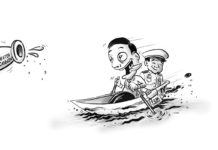FOLLOWING the severe flooding in northern Iloilo caused by typhoon “Ursula” recently, Gov. Arthur Defensor Jr. called for a reassessment of Iloilo’s hazard map prepared by the Mines and Geosciences Bureau (MGB) in Western Visayas. The identified hazard areas might have changed already so we need to review, he said. MGB’s hazard map identified geologic danger zones – areas vulnerable to flooding and landslide – down to the barangay level.
The good governor may have a point but it must be asked, too, if local government units (LGUs) which were all given the maps know how to use, read and interpret them.
LGUs must consult these maps when plotting steps to protect their people from geohazards. More importantly, LGUs must know how to use these geohazard maps to reduce disaster risks. MGB must make sure local officials understand the details on these maps.
In many instances in the past, natural hazards turned into major disasters because of the lack of understanding of the geohazard maps. Communities were built on landslide-prone areas and other danger zones because they were not aware of the risks. MGB must explain to every mayor, city or municipal administrator the details and significance of the maps.
We have to use science to save lives and livelihood. We need to translate science to practice and one way to effectively do that is to make sure that geohazard maps are understood by all, especially by local chief executives and disaster risk reduction officers.
There should be information and education campaign on the importance of the use of geohazard maps. Perhaps this could be done in every school and local government unit through a multi-sectoral workshop.
Our local officials need to have the valuable, life-saving information regarding risks present in their communities, all of which can be found in the geohazard maps. There is therefore a need to educate them on how to read the maps and how these could help them in their disaster risk reduction and management efforts.
We should be able to radically minimize the casualties and damages when a natural hazard strikes with the knowledge of the risks present in our communities.


